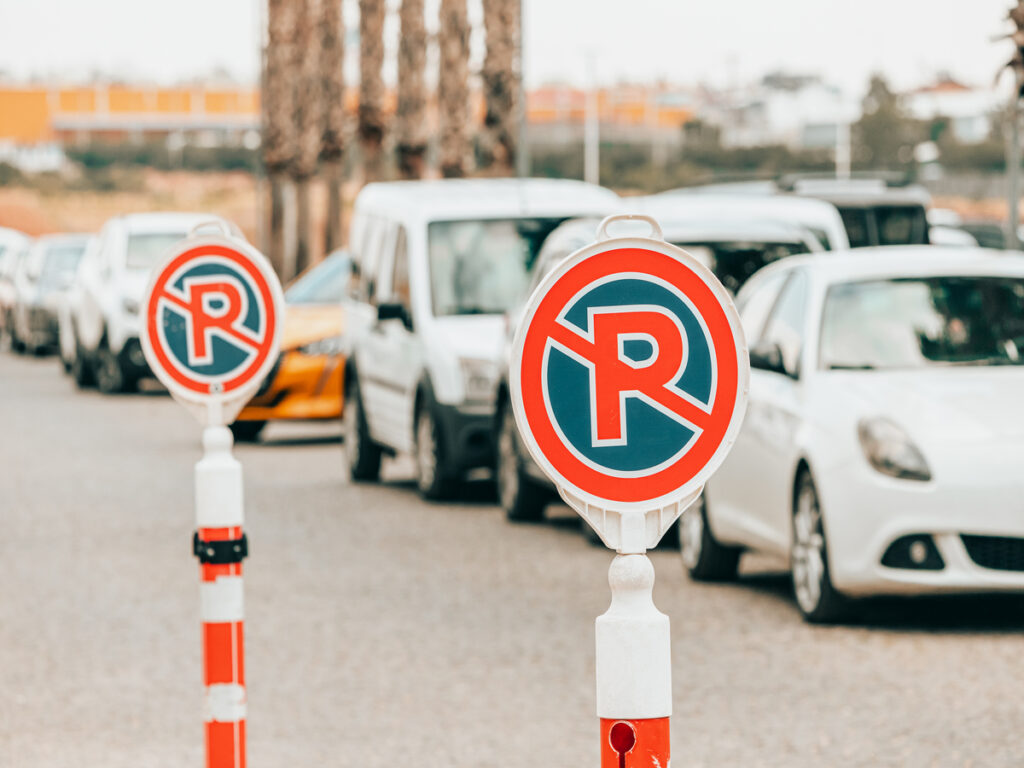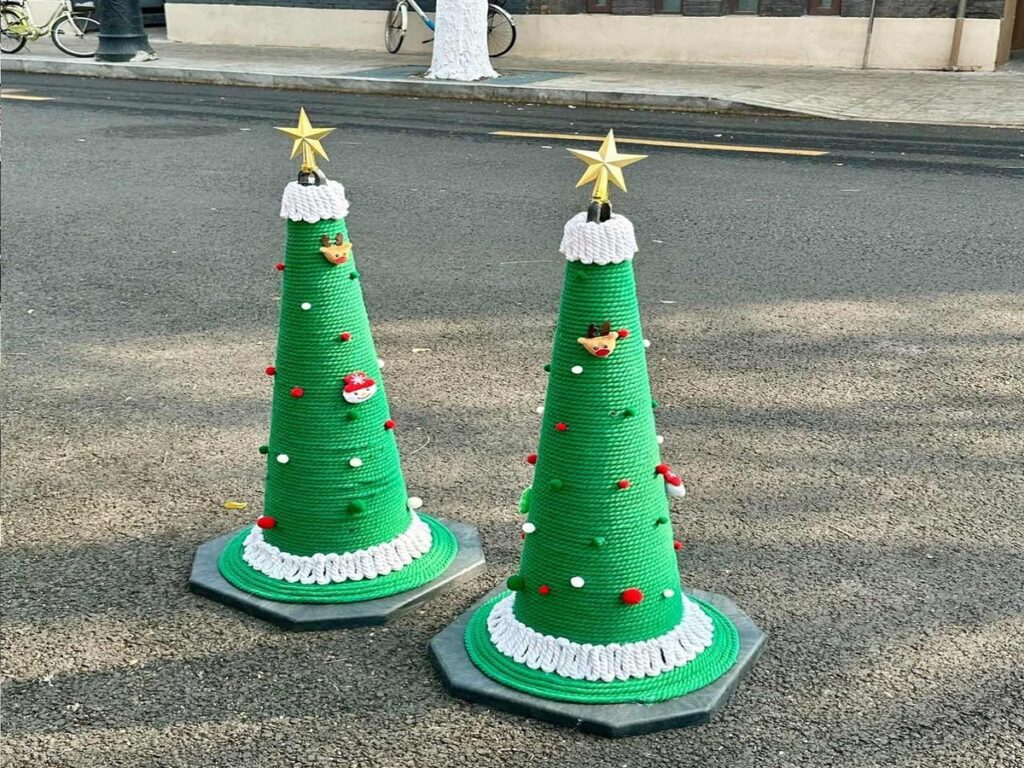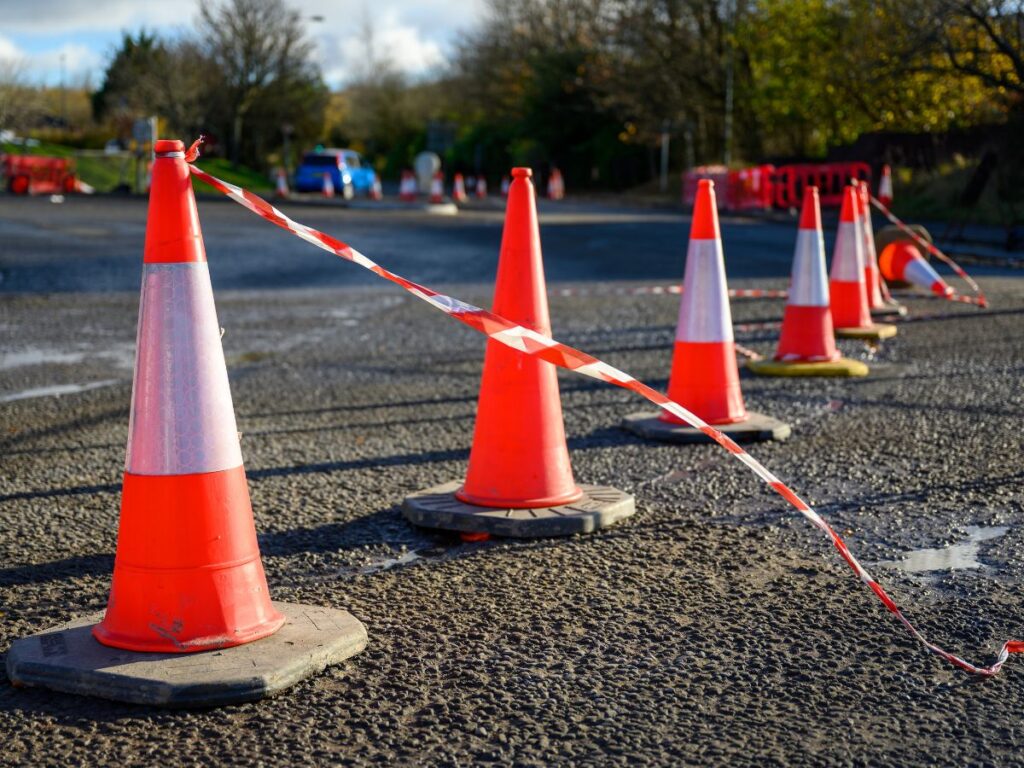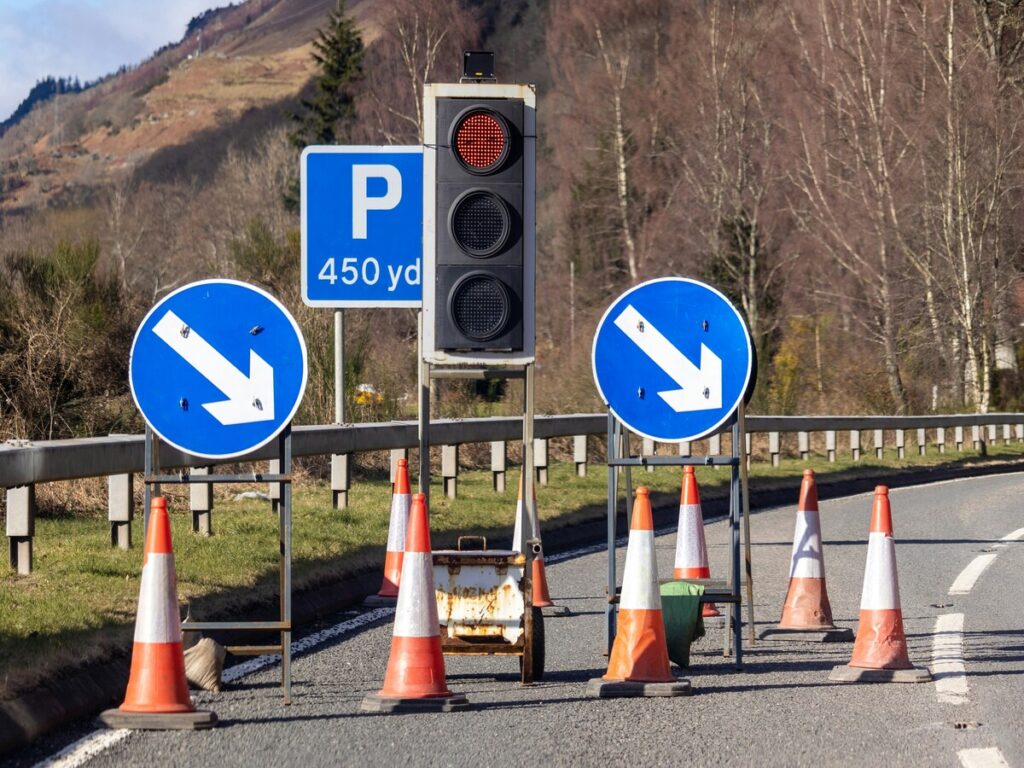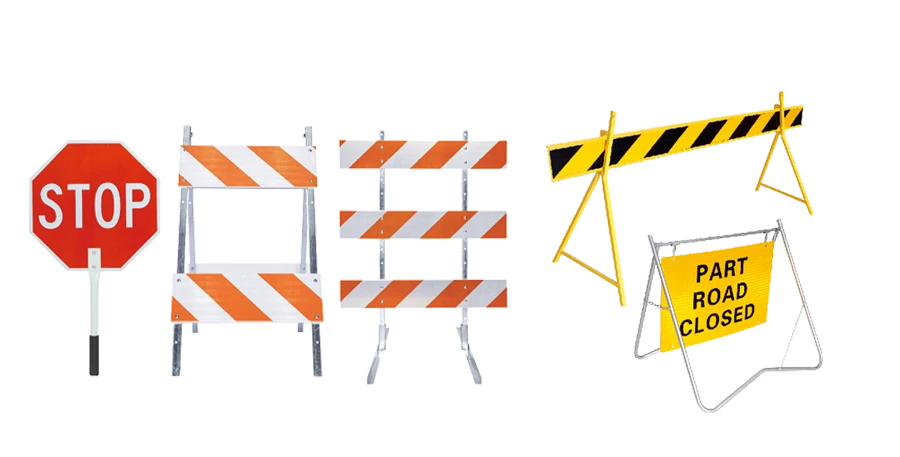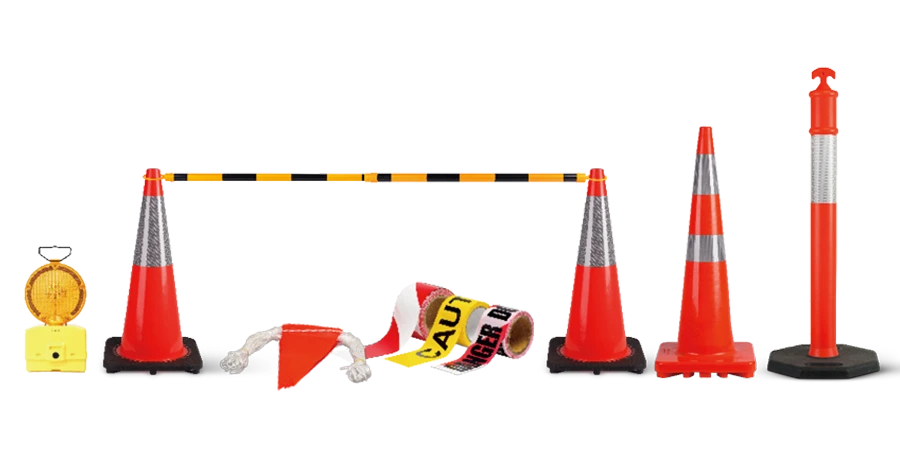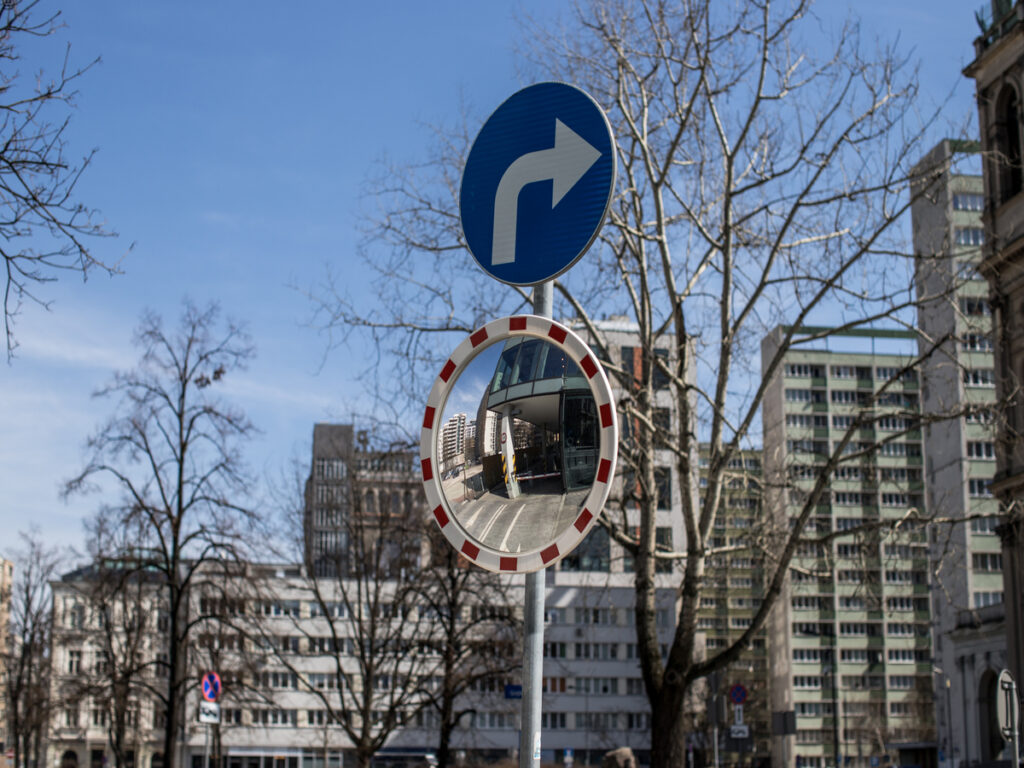
You have three main ways to put up temporary traffic signs in the UK: channel fixings, plate-only, and self-adhesive. Picking the right way is important. Good mounting keeps signs easy to see and steady. This is true even if the sign is made from plastic or thin metal. UK rules say you must put signs at driver eye level. You also need to use approved materials. Health and safety laws help keep workers and drivers safe. They say signs must be mounted safely and checked often. Local councils and highway authorities make sure these rules are followed. Esto ayuda a mantener las carreteras seguras para todos.
En Optraffic, we provide a range of temporary letreros de tráfico designed for easy installation and maximum visibility. Our products comply with UK safety standards, ensuring both effectiveness and compliance. Explore our selection of traffic signage solutions today to keep your roads safe and well-managed.
Control de llave
- Choose the mounting method based on sign size, ubicación, and how long it needs to stay up to keep signs safe and visible.
- Channel fixings offer the strongest hold and work best for large signs on busy or windy roads, but they need tools and more time to install.
- Plate-only mounting is quick, rentable, and good for smaller signs in towns or quiet areas, though less secure in bad weather.
- Self-adhesive signs are fast to install and ideal for short-term use on clean, smooth surfaces but may not last long outdoors.
- Regular checks and proper maintenance keep signs safe, claro, and compliant with UK rules, protecting drivers and workers.
Señales de tráfico temporales: Opciones de montaje
When you need to put up temporary traffic signs, you have three main ways to mount them. Cada método funciona mejor en diferentes situaciones. You should know the basics of each option before you choose.
Fijación de canales
Channel fixings use metal channels on the back of the sign. You attach these channels to posts or poles with special clips or bands. This method gives a strong and steady hold. You often see channel fixings on busy roads or places with strong winds. You can use them for large or heavy signs. Many professionals pick channel fixings when they want a secure and long-lasting solution.
Solo plato
Plate-only mounting means you attach the sign directly to a surface. You might use bolts, tornillos, or even strong adhesives. This method works well for smaller signs. You can install plate-only signs quickly. You often see this method in towns or on quiet roads. Plate-only mounting is a good choice when you need a simple and cost-effective way to display a sign.
Self-Adhesive
Self-adhesive mounting uses a sticky backing on the sign. You peel off the cover and press the sign onto a clean surface. This method is very fast. You do not need tools or extra parts. Self-adhesive signs work best for short-term needs. You might use them at events or during roadworks. You should make sure the surface is clean and dry before you stick the sign.
Consejo: Always match the mounting method to the job. Think about the size of the sign, El clima, and how long you need the sign to stay up.
Fijación de canales
Descripción general
Channel fixings give you a strong and reliable way to mount temporary traffic signs. You use metal channels on the back of the sign. These channels let you attach the sign to a post or pole with special hardware. The main parts include channel clip extrusions, joining brackets, fixing angles, sliders, sign locators, and acrylic clamps. You might also use colour coded fixings, offset brackets, nueces, perno, washers, and even hanging hooks. These parts work together to hold the sign steady, even in windy or busy places.
Instalación
You can install channel fixings by following a few simple steps:
- Clean the pole to remove any dirt or debris.
- Line up the bracket with the slots on the pole.
- Insert bolts through the bracket and the pole slots.
- Tighten the nuts with a wrench, but do not over-tighten.
- Check that the sign and bracket feel secure and stable.
Para una seguridad adicional, use tamperproof nuts or one-way bolts in busy areas. Gaskets between the pole and bracket help stop slipping. Stainless steel bolts resist rust and weather. You should inspect the installation often to keep everything safe and compliant.
Pros
- High durability in all weather
- Secure attachment for large or heavy signs
- Reusable hardware for future projects
- Good for long-term use
Contras
- Needs tools and some skill to install
- Takes more time than other methods
- Higher cost for materials and labour
Aplicaciones
You should use channel fixings for temporary traffic signs on motorways, calzadas duales, or any high-traffic road. They work best for heavy-duty signs or when you need the sign to stay up for a long time. Many professionals choose this method for roadworks, major events, or permanent street signs.
Consejo: Always check your fixings after storms or heavy use to keep your signs safe and visible.
Plate-Only Mounting
Descripción general
Plate-only mounting gives you a simple way to put up temporary traffic signs. You attach the sign directly to a pole, wall, or stand. You can use bolts, tornillos, or strong adhesives. This method does not need extra channels or brackets. You often see plate-only mounting in towns or on quiet roads. Many signs use lightweight materials like aluminium or steel, which makes them easy to move and reuse.
Instalación
You can install a plate-only sign quickly. Primero, choose a clean and stable surface. Próximo, line up the sign and mark where you want to fix it. Use a drill to make holes if you need to. Entonces, attach the sign with bolts or screws. Some signs use strong adhesive pads instead. Always check that the sign feels secure and does not wobble. You do not need special tools for most jobs, so you can finish the work fast.
Consejo: Use portable stands for even quicker setups. These stands help you move signs as needed and keep traffic flowing.
Pros
- Cost-effective for short-term or temporary traffic signs
- Quick and easy to install
- Lightweight signs are easy to move and reuse
- Works well in urban or low-traffic areas
- No need for complex hardware
Contras
- Less secure in strong winds or harsh weather
- Not ideal for large or heavy signs
- May need more checks to keep signs safe
Aplicaciones
You should use plate-only mounting for temporary traffic signs in towns, aparcamiento, or side streets. This method suits events, obras de carretera, or any place where you need signs for a short time. You can also use it when you want to save money and finish the job quickly. Many professionals pick plate-only mounting for its speed and low cost, especially when you need to move signs often.
Self-Adhesive Methods
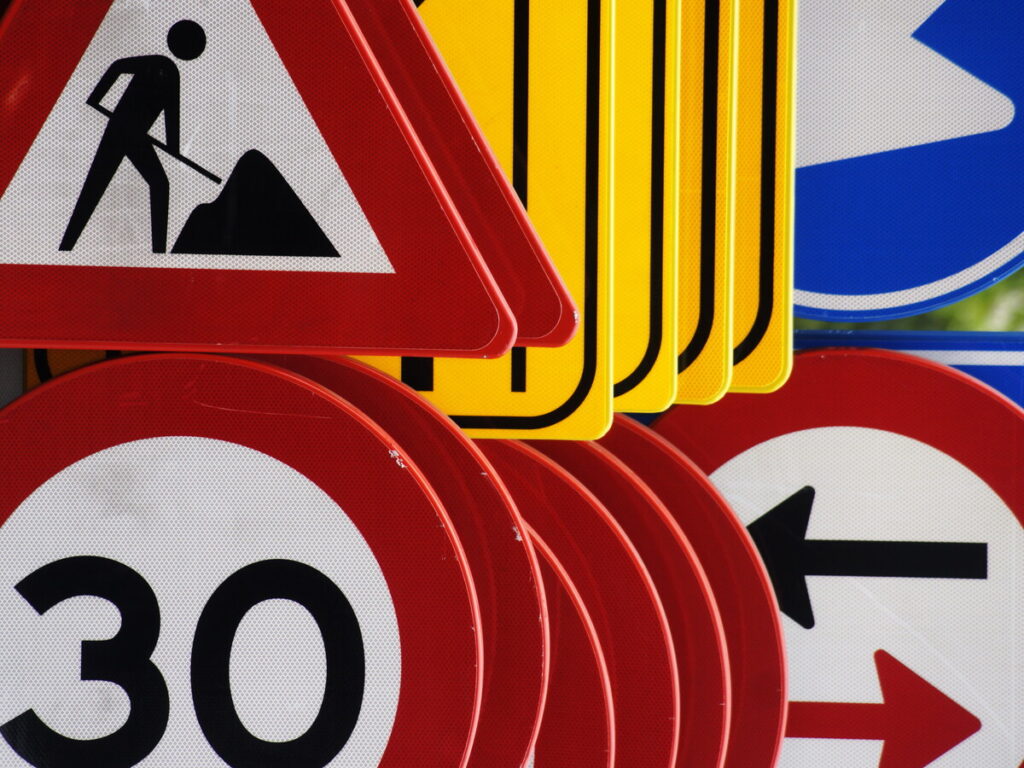
Descripción general
Self-adhesive mounting is a quick and easy way to put up temporary traffic signs. This method uses a sticky back, like structural tape or pressure-sensitive adhesive. You do not need to drill holes or use extra tools. Many self-adhesive signs are made from reflective vinyl, repositionable fabric, or polypropylene film. These materials stick well to smooth surfaces. They help your signs stay bright, Incluso cuando está oscuro.
Self-adhesive signs come in different thicknesses, usually about 80 micras. You can get them with glue that is permanent or removable. These signs work on metal, plástico, madera, vaso, and brick.
| Especificación | Detalles |
|---|---|
| Face Film Thickness | Acerca de 3.2 mil (80 micras) |
| Face Film Type | Matte or Gloss White Phthalate-Free Polymeric PVC |
| Tipo de adhesivo | Grey High Coat Weight Permanent Adhesive |
| Printer Compatibility | Eco Solvent, Latex, Resin, UV printers |
| Durabilidad | Dura hasta 7 years inside or outside with the right laminate |
Instalación
You must clean the surface before you stick on a self-adhesive sign. Use isopropyl alcohol or a mild cleaner to wipe away dust, aceite, o pintura suelta. If the surface is oily, use a citrus-based degreaser and let it dry. For rough or plastic surfaces, try a primer and test a small spot first. Make sure the surface is dry and not too hot or cold.
- Clean and dry the area.
- Pick the right vinyl for the surface.
- Para pequeños letreros, use a dry method. For big panels, use a wet method with soapy water.
- Press the sign from the middle out with a squeegee to get rid of bubbles.
- Check the edges and seal them if they lift.
Consejo: Always check the temperature and humidity before you start. This helps the sticky back hold well and keeps your sign in place.
Pros
- Fast and simple to put up
- No need for tools or drilling
- Does not harm the surface
- Ligero y fácil de transportar
- Works on many surfaces
Contras
| Material/Adhesive Type | Key Issues Reported | Durabilidad al aire libre | Resistencia ambiental |
|---|---|---|---|
| Peel and Stick Vinyl Labels | puede desvanecerse, not very strong against chemicals, does not last long outdoors | 3 a 7 años | Sunlight and hot or cold weather can make them peel or break |
| Adhesive Vinyl Signs | Only guaranteed for 5 años, may fade or lose stickiness | Acerca de 5 años | Sun and temperature changes can make them wear out faster |
| Removable Adhesives | Not very strong, best for inside or gentle use | Corto plazo, Mejor en interiores | Not good for outside, does not stick as well |
| Polyester Labels with Low-Tack Adhesive | Made for short use inside only | Only for indoor use | Not good for outside at all |
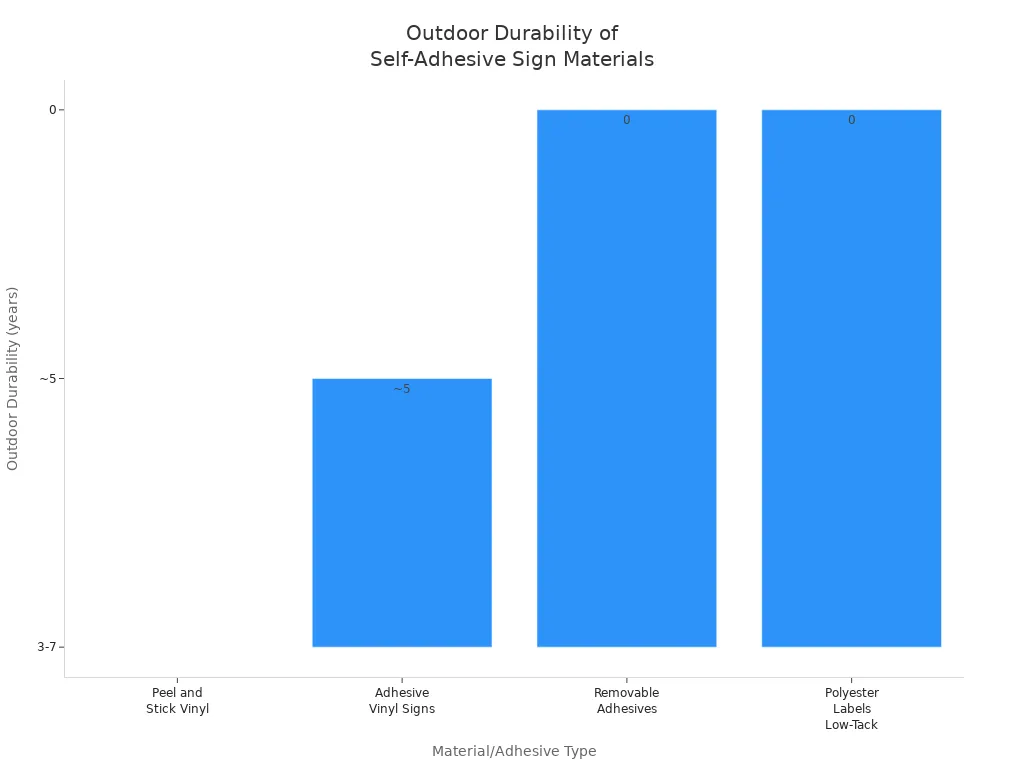
You might see that self-adhesive signs can fade or stop sticking after a while, especialmente afuera. Sunlight and changes in temperature can make them not last as long. Removable adhesives are best for inside or for signs you only need for a short time.
Aplicaciones
Self-adhesive mounting is good for events, sitios de construcción, or anywhere you need a sign for a short time. This method works best on clean, smooth places like painted walls, vaso, o metal. You might use self-adhesive signs for festivals, obras de carretera, or pop-up car parks. They help you save time and do not damage surfaces, so they are a smart choice when you need to change signs quickly.
Comparing Mounting Methods
When you choose how to mount temporary traffic signs, necesitas pensar en varios factores importantes. Each method has strengths and weaknesses. You want to pick the best option for your project. Let’s look at how channel fixings, plate-only, and self-adhesive methods compare.
Durabilidad
Durability means how well the sign stays in place and how long it lasts. Channel fixings give you the strongest hold. You can trust them in strong winds and busy roads. They keep large or heavy signs steady for a long time. Plate-only mounting works well for lighter signs. You can use it in towns or places with less traffic. It does not hold up as well in harsh weather. Self-adhesive signs are best for short-term use. You can put them up quickly, but they may not last long outside. Lluvia, sol, and wind can make them peel or fade.
Nota: If you need a sign to stay up for weeks or months, channel fixings are the safest choice.
| Método de montaje | Nivel de durabilidad | Mejor caso de uso |
|---|---|---|
| Fijación de canales | Alto | A largo plazo, exterior, señales pesadas |
| Solo plato | Medio | Corto plazo, letreros de luz, áreas urbanas |
| Self-Adhesive | Bajo a medio | Very short-term, indoor or mild weather |
Tiempo de instalación
You want to save time when you put up signs. Self-adhesive methods are the fastest. You just peel and stick. You do not need tools or extra parts. Plate-only mounting is also quick. You can use screws or bolts and finish the job in minutes. Channel fixings take the most time. You need to use special hardware and tools. You may need more than one person for large signs.
- Self-adhesive: Fastest, great for quick jobs.
- Plate-only: Rápido, but needs some tools.
- Channel fixings: Slowest, but gives the strongest hold.
Consejo: For emergencies or events, self-adhesive signs help you act fast.
Costo
Cost matters for every project. Self-adhesive signs cost the least. You do not need to buy extra hardware. Plate-only mounting is also affordable. You only need basic screws or bolts. Channel fixings cost more. You pay for special brackets, clips, and sometimes extra labour. But you get a strong and reusable system.
| Método de montaje | Nivel de costo | Notas |
|---|---|---|
| Fijación de canales | Alto | Best for long-term value |
| Solo plato | Medio | Good for most short-term needs |
| Self-Adhesive | Bajo | Best for temporary traffic signs and events |
Idoneidad
You need to match the mounting method to your environment and project needs. Channel fixings work best on busy roads, autopista, or places with strong winds. You should use them for large or heavy temporary traffic signs. Plate-only mounting fits urban streets, aparcamiento, or quiet roads. You can use it for signs that move often. Self-adhesive methods suit events, sitios de construcción, or places where you need signs for a short time. You can use them indoors or on clean, smooth surfaces.
Recordar: Always check the weather and traffic before you choose a mounting method. The right choice keeps everyone safe and your signs visible.
Best Practices for Temporary Traffic Signs
Consejos de selección
You should always choose the mounting method that matches your project needs. Start by thinking about the size and weight of your sign. Large or heavy signs need strong support, so channel fixings work best. For smaller signs, plate-only or self-adhesive methods save time and effort. Look at the location. Busy roads or windy areas need secure fixings. In towns or for short-term events, lighter options work well. Always check the surface before using self-adhesive signs. Limpio, smooth surfaces help the sign stick better.
Consejo: Use reflective materials for better visibility, Especialmente por la noche o en mal tiempo.
Cumplimiento
You must follow Reglas del Reino Unido when you install temporary traffic signs. Many common problems can lead to accidents or fines. Here are some key points to remember:
- Place signs at the correct height and in the right spot. Señales que son demasiado altas, demasiado bajo, or in the wrong place can confuse drivers.
- Use only approved sign panels and mounting equipment. Unapproved items may not meet Departamento de transporte estándares.
- Keep sight lines clear. Do not let trees, autos estacionados, or other objects block the sign.
- Give drivers enough warning. Use advance signs to help them prepare for changes ahead.
- Check alignment. Make sure signs face oncoming traffic and do not reflect sunlight into drivers’ eyes.
Regular checks after installation help you keep your signs safe and legal.
Mantenimiento
You need to look after your signs to keep roads safe. Inspect signs often, especially after storms or busy periods. Replace faded or damaged panels quickly. Usar Materiales reflectantes de alta calidad to keep signs visible at night. Secure frames with weights like sandbags to stop them from falling or blocking paths. Tighten bolts and check adhesive edges to prevent signs from coming loose. Good maintenance keeps your temporary traffic signs effective and compliant.
You can pick from a few ways to put up temporary traffic signs. Channel fixings keep signs safe and strong for a long time. Plate-only methods are good if you want to save money and need signs for a short time. Self-adhesive options are best for special signs or signs inside. The table below shows how each way is different:
| Método de montaje | Performance Characteristics | Mejor caso de uso |
|---|---|---|
| Fijación de canales | Seguro, durable, resistente a la intemperie | Permanent or long-term outdoor signage |
| Solo plato | Ligero, flexible, rentable | Temporario, short-term, or urban environments |
| Self-Adhesive | Customisable, tool-free, Instalación rápida | Specialised, interior, or short-term applications |
You should always choose the right way for your project and where the sign will go. New ideas like lighter frames and magnetic bases help make putting up signs safer and quicker. Si no está seguro de qué hacer, check the rules or ask an expert to keep signs safe and easy to see.
Preguntas frecuentes
What is the best mounting method for windy areas?
You should use channel fixings in windy areas. This method gives your sign a strong and stable hold. It keeps large or heavy signs safe, Incluso en mal tiempo.
Can you reuse temporary traffic signs after removal?
Sí, you can reuse most temporary traffic signs. Channel fixings and plate-only signs work well for this. Always check the sign and hardware for damage before you use them again.
Do self-adhesive signs stick to all surfaces?
Self-adhesive signs work best on clean, smooth surfaces like metal or glass. If you try to stick them to rough or dirty surfaces, they may not hold well.
How often should you check temporary traffic signs?
You should check your signs every day, especially after storms or busy periods. Look for loose fixings, faded panels, or signs that have moved out of place.
Are there rules for the height of temporary traffic signs?
Sí, UK rules say you must place signs at driver eye level. This helps drivers see and read the signs quickly. Always follow local guidelines for sign placement.

